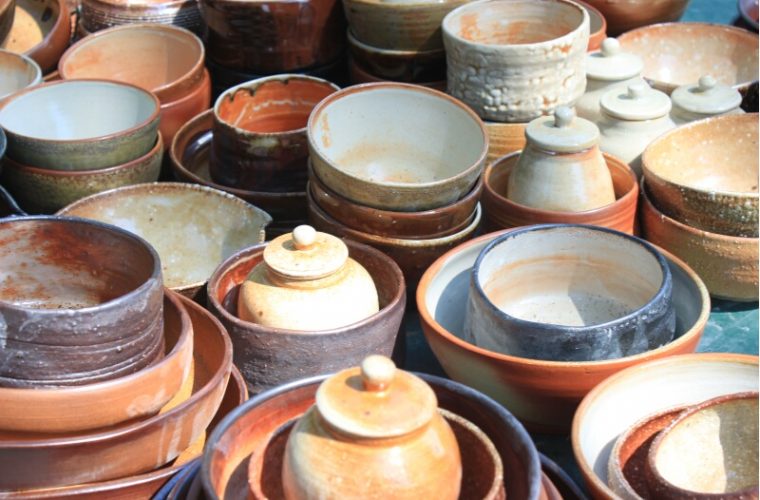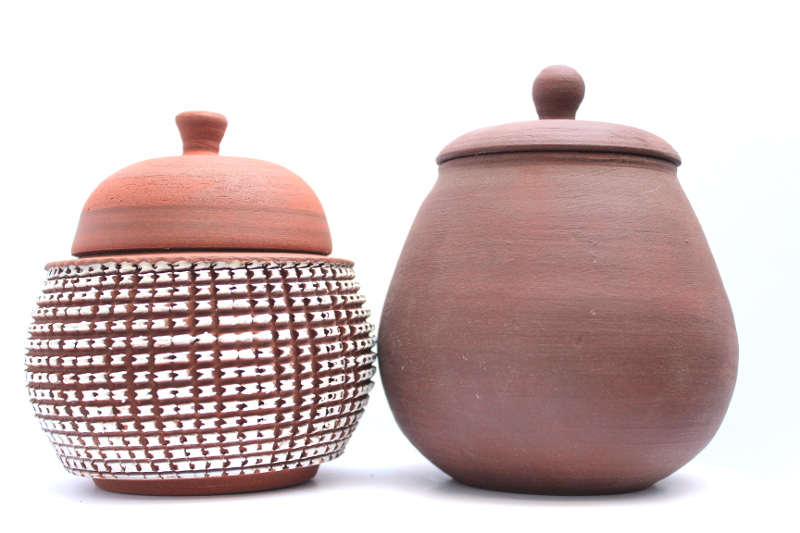Gustav Weiß describes on his page in the internet a possibility to create glazes for the electrical kiln (oxygene atmosphere), that show an “inner reduction” without changing the kilns atmosphere. The principle is rather simple: Silicium, added to the glaze, will absorb the oxygene from the metal oxides in the melt and the desired reduction… Read More
Category: Potter´s blog
Yes, I am a physicist and hence I do not believe. But because I do not believe, I must experiment and measure. Gustav Weiß has published an article in the internet about the use of Efficient Micro Organisms (EM) to avoid re-oxidation of metals in a melted glazes under silicium induced intrinsic reduction. The EMs… Read More
It is always worth to look closer to glazes and ceramic surfaces. You can find details on the surface, that are opening a completely new world. For this I would like to point to the chapter “The Beauty is Hidden in the Details” in my shop.
The firing in May produced many accent pots for the shop but also a large amount of bonsai pots, where I tested my new glazes. Many of the glazes are very promising and bonsai pots with this glazes will be seen in the shop in the future.
This post will show pictures of one of my Gozu glazes, Lucas glaze, Some Bright Green, Tenmoku, Pale Ash, Celadon 3 and a Flake Shino that got too much salt and ash. Gosu Glaze Lucas Glaze Some Bright Green Tenmoku Pale Ash Seladon 3 Flake Shino
This post will show pictures of Shrinking Shino, the Baltic Sea glaze this time in woodfiring, Celadon 4, Malcom Shino and a local Loess glaze. Shrinking Shino Baltic Sea Glaze Celadon 4 Malcom Shino Local Loess Glaze
This post will show pictures of a Nuka glaze with extra iron, American Shino, Pier Black, Haystack Orange and Reitz Green. Nuka Glaze with Iron American Shino Pier Black Haystack Orange Reitz Green
The focus of theses firings was on tea ceramics and glazed bonsai pots. Some containers and cups were also in the kiln. The results are remarkable and can be seen in more detail in the following posts.
The wood firing in may 2018 was spectacular. The weather was perfect and we fired 2 kilns. Some impressions of the firing can be seen below. The results of the experiments will be described in more detail in the following posts. All in all I am absolutely happy, however I have already more ideas… Read More
Because of my bonsai pots I am always looking for a red stoneware clay that is frost resistant and has exactly the color, THE color, a dark, violet red-brown that is simply not describable. Some years ago I experimented with various iron oxides and could achieve very good results. Only the application of the iron… Read More
Chawan 4586 Hello, I plan to show periodically some of the products for sale in more details. Today I describe a tea bowl, the Chawan 4586. Data: Material: Stoneware clay. A lightly grogged white clay body. Production: Base shape thrown on pottery wheel, partially formed manually afterwards. Dimensions: Diameter approx. 11cm, Height approx. 8cm Firing:… Read More
A new porcelain and clay body Markus Böhm has developed a new porcelain body especially for usage in wood fires. Of course I needed to do some material tests with this porcelain. The body is stable at 1300°C, is getting translucent and shows the pink color effects caused by the minimal iron oxide contamination. The… Read More
This summer we had the stupid idea to develop a glaze that consists solely of materials that can be found on the shore of the Baltic Sea. Talcum and flint stone are easy to identify but what about feldspar? The moraine rubble contains many different materials and granite can have high amounts of feldspar (besides… Read More
To measure the degree of reduction in the wood fired kilns, I fired a set of glaze samples in a capsule (with a piece of coal for additional reduction).In the following picture are the results of the capsule (inner side) and of the kiln (outer side) shown. 1: Hamada 2: Pale Ash 403 3: Local… Read More













